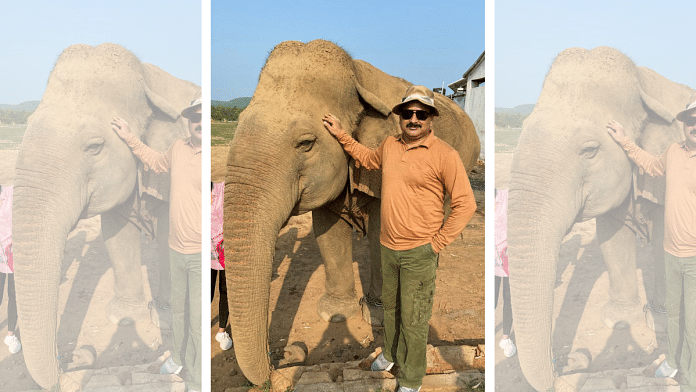New Delhi: She was born in the lush green forests of Kerala, but it was in Panna that Vatsala came into her own. In Vatsala’s passing away Tuesday, the tiger reserve lost its grand matriarch and Madhya Pradesh a slice of its fauna history.
Believed to be world’s oldest female elephant, Vatsala was aged approximately 105 years and a favourite of forest guards, officers, mahouts, and visitors alike who called her ‘Dadi Maa’ for her gentle ways, be it in raising calves or guiding the captive herd of elephants.
Her mahouts claim that Vatsala was around 52-year-old, when she was captured in Kerala’s Nilambur forests in 1972.
Since then, she has worked with different divisions of the Madhya Pradesh forest department—first in the Bori wildlife sanctuary, then in Hoshangabad in the production division, and finally in Panna Tiger Reserve since 1993. At Panna, she was part of the group of elephants used by the forest department for tiger tracking and monitoring within the reserve’s premises.
“In many ways, she defied time. While most elephants live only up to 60-70 years, here was one that was over 100 years old,” Susanta Nanda, a retired Indian Forest Service (IFS) officer from Odisha who first saw Vatsala in 2010, told ThePrint.
In Panna, Vatsala was seen as the ‘matronly’ older elephant who would take care of the female elephants and calves in the elephant camp. Her last few years were in the Hinauta camp near the Hinauta gate, where she was the oldest amongst 19 elephants. She worked in the tiger tracking and monitoring department until 2004 when she ‘retired.’
The pachyderm spent her time in different elephant camps inside the reserve, as mahouts took care of her. On Tuesday, she sat down, unable to walk after an injured toenail. While her mahouts tried to make her stand up, their attempts failed and at 1.30 p.m. afternoon she was declared dead.
Anupam Sharma, Divisional Forest Officer (DFO) of Panna Tiger Reserve’s south division, made a moving post on ‘X’, recalling Vatsala’s gentle presence that inspired awe in all who met her.
With heavy hearts, we bid farewell to Vatsala, >100-old matriarch of Panna Tiger Reserve. Her gentle presence inspired awe in all who met her. Thank you, Vatsala, for countless rescue operations & nurturing many Elephant calves. Your legacy lives on. 🐘🙏 pic.twitter.com/DJ9vmhoGPl
— Anupam Sharma, IFS (@AnupamSharmaIFS) July 8, 2025
“There have been times when female elephants were giving birth when Vatsala would be standing there, showing support,” Anjana Tikrey, field director of Panna Tiger Reserve, told ThePrint. “Elephants are very social animals, and Vatsala would display that, often caring for newly-birthed calves too.”
Vatsala never mated or birthed any known children in captivity, although she was brutally attacked and injured by a male tusker twice, once in 2003 and in 2008.
Tikrey explained how the tusker was trying to dominate the camp and attacked Vatsala in aggression, due to which she sustained injuries in her intestines. Towards the end of her life, she remained old and sick. In her later years, around 2021, Vatsala also lost her eyesight and was totally blind, and also had digestive problems.
“She would be taken care of entirely by the mahouts in the last few years, being fed and walked around by them. Because of her digestive issues she would only eat dahlia everyday,” Tikrey said. “Sometimes they would walk her down to Khairaiya Nala for bathing, but not too far because she was old and would tire easily.”
Also Read: Inside CCMB Hyderabad—where scientists turn elephant blood, tiger bones into criminal evidence
Life & times of gentle giant
Since she was born in the wild, little is known of Vatsala’s life from before 1972. However, she was widely claimed as “the world’s oldest Asian elephant” and “India’s oldest elephant” despite no official records of her birth. In 2021, local news reported that the forest authorities were trying to enter her in the Guinness Book of World Records.
“Without her birth certificate or any record of when she was born, we could never enter her for the world record. But she was famous nonetheless, a favourite of tourists,” Tikrey recalled.
According to Nanda, who first met Vatsala in 2010 on a training session held at the Panna Tiger Reserve, she also played a major role in Panna’s tiger tracking activities. In many tiger reserves within India, even now, elephants are used to rescue tigers and cubs who have either strayed out of the reserve or are stuck after birthing, infighting, and other emergency situations.
In People’s Archive of Rural India published October last year, a report mentions the endearing bond of over two decades between Vatsala and mahout Maniram Gond. Maniram recalled how the elephant saved him from a tiger as she came running on hearing her voice. “She lifted her front leg so that I could climb onto her back. Once I was seated, she stomped her feet and tore down trees. Tiger bhaag gaya [the tiger ran away],” he said.
Tributes poured in, especially from the fraternity of forest personnel and wildlife-lovers. Many of them shared a clip of Vatsala wading through knee-deep waters, gently ambling on her way to the river bank.
Abhinav Pandey, a wildlife cinematographer and photographer, wrote that he “lost one more mother”. “My first day was spent with Vatsala of Panna. And from 11 years every time I go to Hinuta meet with Vatsala maa. If mother has to be defined then there is no better example than Vatsala, who has given love and care to many children of other elephants,” he posted on ‘X’.
“With heavy hearts, we bid farewell to ‘Vatsala’, the centenarian elephant of Panna Tiger Reserve. Her remarkable life leaves behind an enduring legacy for wildlife lovers and conservationists,” Rajya Sabha MP Praful Patel said in a post on X.
(Edited by Tony Rai)
Also Read: It’s official: New object zipping through our solar system is the 3rd known interstellar visitor






